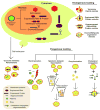Achieving the Promise of Therapeutic Extracellular Vesicles: The Devil is in Details of Therapeutic Loading
- PMID: 28315083
- PMCID: PMC5565485
- DOI: 10.1007/s11095-017-2123-5
Achieving the Promise of Therapeutic Extracellular Vesicles: The Devil is in Details of Therapeutic Loading
Abstract
Extracellular vesicles (EVs) represent a class of cell secreted organelles which naturally contain biomolecular cargo such as miRNA, mRNA and proteins. EVs mediate intercellular communication, enabling the transfer of functional nucleic acids from the cell of origin to the recipient cells. In addition, EVs make an attractive delivery vehicle for therapeutics owing to their increased stability in circulation, biocompatibility, low immunogenicity and toxicity profiles. EVs can also be engineered to display targeting moieties on their surfaces which enables targeting to desired tissues, organs or cells. While much has been learned on the role of EVs as cell communicators, the field of therapeutic EV application is currently under development. Critical to the future success of EV delivery system is the description of methods by which therapeutics can be successfully and efficiently loaded within the EVs. Two methods of loading of EVs with therapeutic cargo exist, endogenous and exogenous loading. We have therefore focused this review on describing the various published approaches for loading EVs with therapeutics.
Keywords: EV therapeutics; drug loading; exosomes; extracellular vesicles; microvesicles.
Figures


References
-
- Pan BT, Johnstone RM. Fate of the transferrin receptor during maturation of sheep reticulocytes in vitro: selective externalization of the receptor. Cell. 1983;33(3):967–78. - PubMed
-
- Valadi H, Ekstrom K, Bossios A, Sjostrand M, Lee JJ, Lotvall JO. Exosome-mediated transfer of mRNAs and microRNAs is a novel mechanism of genetic exchange between cells. Nat Cell Biol. 2007;9(6):654–9. - PubMed
Publication types
MeSH terms
Substances
Grants and funding
LinkOut - more resources
Full Text Sources
Other Literature Sources

